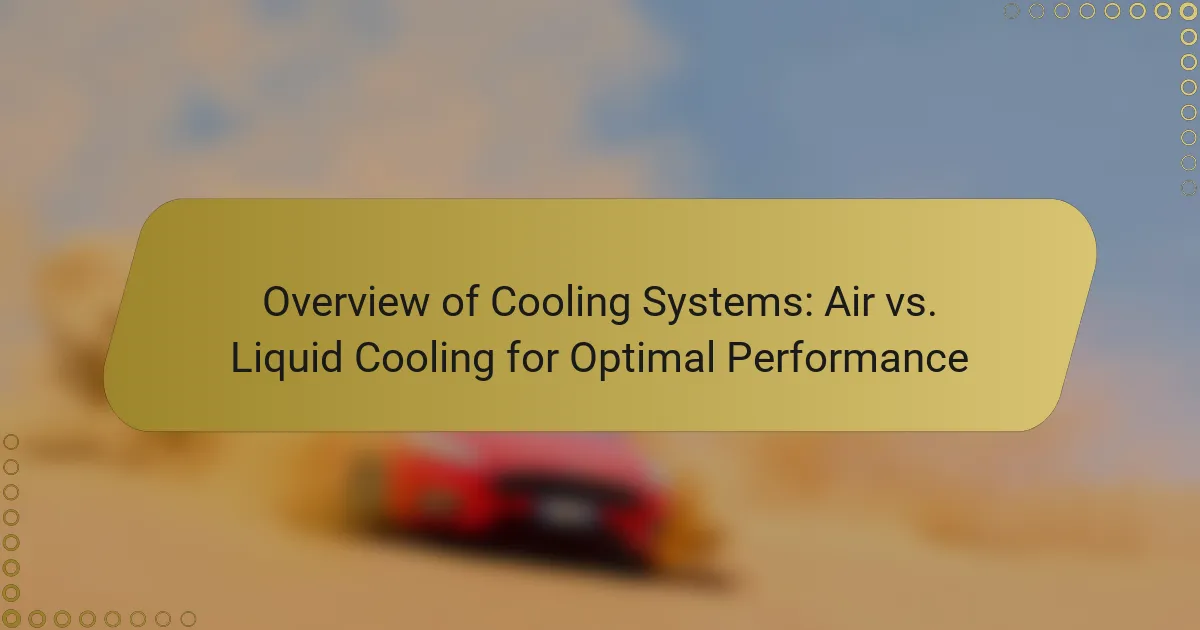Cooling systems are essential mechanisms that remove excess heat from environments or objects to maintain optimal operating temperatures. This article provides an overview of two primary cooling methods: air cooling and liquid cooling. Air cooling relies on fans and heatsinks to dissipate heat, making it a cost-effective and straightforward solution for various applications. In contrast, liquid cooling utilizes a closed-loop system with coolant to achieve more efficient heat transfer, resulting in lower temperatures and enhanced performance. Key comparisons will be made between the two methods, highlighting their effectiveness, energy efficiency, and impact on equipment longevity.

What are Cooling Systems and Why are They Important?
Cooling systems are mechanisms designed to remove excess heat from an environment or object. They are crucial for maintaining optimal operating temperatures in various applications, such as computers and industrial machinery. Effective cooling prevents overheating, which can lead to equipment failure and reduced performance. For instance, in computer systems, cooling solutions like fans or liquid cooling systems help maintain temperatures below 85 degrees Celsius. This is essential for the longevity and reliability of components. Additionally, cooling systems enhance energy efficiency by reducing the need for excessive power consumption due to overheating. Overall, their importance lies in safeguarding equipment, improving efficiency, and extending service life.
How do Cooling Systems function in various applications?
Cooling systems function by removing excess heat from an environment or object. They utilize various methods to achieve temperature regulation. In air cooling systems, fans circulate air over heat sinks. This process dissipates heat into the surrounding environment. Liquid cooling systems, on the other hand, use fluids to absorb and transfer heat. These systems often involve pumps to circulate coolant through pipes and radiators.
In computer applications, cooling systems prevent overheating of components like CPUs and GPUs. In automotive applications, they maintain engine temperature for optimal performance. Industrial cooling systems regulate temperatures in manufacturing processes. Each application requires specific design considerations for efficiency. Thus, cooling systems play a critical role across diverse fields.
What are the primary components of Cooling Systems?
The primary components of cooling systems include the compressor, condenser, evaporator, and expansion valve. The compressor circulates refrigerant and compresses it to a high-pressure gas. The condenser cools the gas, turning it into a liquid by dissipating heat. The evaporator absorbs heat from the environment, allowing the refrigerant to evaporate back into a gas. The expansion valve regulates the flow of refrigerant into the evaporator. These components work together to maintain optimal temperatures in various applications, from HVAC systems to computer cooling.
How do different environments affect Cooling System performance?
Different environments significantly impact cooling system performance. High ambient temperatures can decrease the efficiency of both air and liquid cooling systems. In hot environments, air cooling systems struggle to dissipate heat effectively. This results in higher operating temperatures for the components. Liquid cooling systems, however, can maintain better performance due to their higher heat capacity. Conversely, low ambient temperatures can enhance cooling efficiency. In cold environments, air cooling systems may perform better than expected. Liquid cooling systems may also benefit but can risk freezing if not properly managed. Humidity levels also play a role; high humidity can reduce the effectiveness of air cooling systems. Overall, environmental factors directly influence thermal management capabilities of cooling systems.
What are the main types of Cooling Systems?
The main types of cooling systems are air cooling and liquid cooling. Air cooling uses fans and heat sinks to dissipate heat. This method is commonly found in computers and HVAC systems. Liquid cooling involves circulating a coolant through a system to absorb and transfer heat. It is often used in high-performance applications like gaming PCs and industrial machinery. Both systems aim to maintain optimal operating temperatures. Air cooling is generally simpler and more cost-effective. Liquid cooling provides superior heat management for demanding tasks.
What distinguishes Air Cooling from Liquid Cooling?
Air cooling uses fans to dissipate heat from components, while liquid cooling utilizes a liquid coolant to transfer heat away. Air cooling is generally simpler and easier to install. It requires less maintenance compared to liquid cooling systems. Liquid cooling can achieve lower temperatures more effectively, making it suitable for high-performance applications. Air cooling is often quieter than liquid cooling systems, which can produce noise from pumps and fans. Liquid cooling systems can be more expensive due to their complexity and additional components. Overall, air cooling is ideal for standard use, while liquid cooling is preferred for overclocking and intensive tasks.
What are the advantages and disadvantages of each Cooling System type?
Air cooling systems are cost-effective and easy to install. They require minimal maintenance and are generally quieter than liquid cooling systems. However, air cooling may not be as efficient in high-performance scenarios. It can lead to higher temperatures in overclocked systems.
Liquid cooling systems offer superior thermal management. They can dissipate heat more effectively, especially in high-performance setups. Liquid cooling is often quieter under load. However, these systems are more expensive and complex to install. They require regular maintenance to prevent leaks and ensure optimal performance.

What is Air Cooling and How Does it Work?
Air cooling is a method used to lower temperatures by circulating air over heat-producing components. It primarily relies on fans to move air across heatsinks or radiators. The airflow dissipates heat away from the components, maintaining optimal operating temperatures.
In computer systems, air cooling typically involves heatsinks made of materials like aluminum or copper. These materials have high thermal conductivity, allowing them to absorb and transfer heat efficiently. Fans then draw cooler air into the system and expel warmer air, creating a continuous cycle.
Air cooling is widely used due to its simplicity and cost-effectiveness. It does not require complex systems or maintenance, making it accessible for most users. Additionally, it can effectively manage heat in various applications, from personal computers to industrial machinery.
What are the key components of an Air Cooling System?
The key components of an air cooling system include the fan, heat sink, and thermal interface material. The fan circulates air to dissipate heat. The heat sink absorbs and transfers heat away from components. Thermal interface material enhances heat conduction between the heat sink and the component. These components work together to maintain optimal operating temperatures. Efficient air cooling systems prevent overheating and improve system performance.
How does airflow impact the efficiency of Air Cooling?
Airflow significantly influences the efficiency of air cooling systems. Proper airflow enhances heat dissipation from components. Increased airflow reduces the temperature of the air around the cooling unit. This leads to better thermal management and improved cooling performance. Insufficient airflow can cause heat buildup, reducing system efficiency. A study by the ASHRAE (American Society of Heating, Refrigerating and Air-Conditioning Engineers) indicates that optimal airflow can improve cooling efficiency by up to 30%. Therefore, maintaining adequate airflow is crucial for maximizing air cooling effectiveness.
What factors influence the performance of Air Cooling Systems?
The performance of air cooling systems is influenced by several key factors. These include ambient temperature, humidity levels, and airflow efficiency. Higher ambient temperatures can reduce cooling efficiency. Increased humidity can hinder the system’s ability to remove heat effectively. Airflow efficiency is critical; inadequate airflow can lead to hot spots and reduced cooling performance. Additionally, the design of the heat sink and fan speed plays a significant role. Optimized heat sink design enhances heat dissipation. Fan speed adjustments can improve airflow, impacting overall cooling effectiveness. Regular maintenance, such as dust removal, also affects performance. Clean components ensure optimal airflow and heat transfer.
What are the benefits and limitations of Air Cooling?
Air cooling systems provide efficient temperature regulation for various applications. They are typically less expensive to install and maintain than liquid cooling systems. Air cooling is also easier to implement, requiring less complex infrastructure. Additionally, air cooling systems are often lighter and more compact, making them suitable for a variety of setups.
However, air cooling has limitations. It may not be as effective in high-performance scenarios where heat generation is significant. Air cooling systems can struggle with maintaining optimal temperatures in densely packed environments. They also tend to be noisier due to the operation of fans. Furthermore, air cooling is less efficient in extreme temperatures, impacting overall performance.
How does Air Cooling compare in cost-effectiveness?
Air cooling is generally more cost-effective than liquid cooling. Air cooling systems have lower initial installation costs. They require less maintenance and are easier to install. Energy consumption tends to be lower in air cooling systems. This results in reduced electricity bills over time. According to a study by the U.S. Department of Energy, air cooling systems can save up to 25% on energy costs compared to liquid cooling. Additionally, air cooling systems do not require the purchase of coolant or complex plumbing. This further enhances their cost-effectiveness.
In what scenarios is Air Cooling the preferred option?
Air cooling is preferred in scenarios where cost-effectiveness and simplicity are essential. It is often chosen for systems with lower thermal demands, such as entry-level PCs or basic servers. Air cooling systems are easier to install and maintain compared to liquid cooling solutions. They do not require additional components like pumps or reservoirs, reducing potential failure points. Air cooling also effectively manages temperatures in environments with moderate heat generation. Additionally, air coolers are less prone to leaks, making them safer for sensitive electronic components. In summary, air cooling is ideal for budget-conscious users and less demanding applications.

What is Liquid Cooling and How Does it Work?
Liquid cooling is a thermal management method that uses liquid to transfer heat away from components. It typically involves a closed-loop system where a coolant circulates through a series of pipes and blocks. The coolant absorbs heat from the components, such as CPUs or GPUs, and then moves to a radiator. At the radiator, the heat is dissipated into the air, allowing the coolant to cool down. This process is more efficient than air cooling due to the higher thermal conductivity of liquids. Liquid cooling systems can maintain lower temperatures, which enhances performance and prolongs component lifespan. Studies show that liquid cooling can reduce temperatures by 20-30% compared to air cooling methods.
What are the essential components of a Liquid Cooling System?
The essential components of a liquid cooling system include a pump, radiator, water block, reservoir, and tubing. The pump circulates the coolant throughout the system. The radiator dissipates heat from the coolant into the air. The water block transfers heat from the CPU or GPU to the coolant. The reservoir holds extra coolant and allows for air removal from the system. Tubing connects all components and transports the coolant. These components work together to maintain optimal temperatures in high-performance computing systems.
How does liquid flow enhance cooling efficiency?
Liquid flow enhances cooling efficiency by increasing heat transfer rates. It allows for more effective absorption of heat from surfaces. Liquid has a higher thermal conductivity compared to air. This means it can carry heat away more efficiently. The continuous movement of liquid prevents hot spots from forming. It promotes uniform temperature distribution across the cooling system. Studies show that systems utilizing liquid cooling can operate at lower temperatures. This results in improved performance and longevity of components.
What factors contribute to the effectiveness of Liquid Cooling?
The effectiveness of liquid cooling is influenced by several key factors. The thermal conductivity of the liquid is crucial; liquids with high thermal conductivity transfer heat more efficiently. The flow rate of the coolant also matters; higher flow rates enhance heat dissipation. The design of the cooling system impacts effectiveness; optimized layouts promote better heat exchange. The surface area of heat exchangers is significant; larger areas allow for more effective heat transfer. Additionally, the ambient temperature affects performance; lower ambient temperatures improve cooling efficiency. Lastly, the quality of the pump influences circulation; efficient pumps maintain consistent coolant flow.
What are the benefits and limitations of Liquid Cooling?
Liquid cooling offers efficient heat dissipation and enhanced performance for electronic systems. It circulates coolant through a closed loop to absorb heat, maintaining optimal operating temperatures. This method can significantly reduce temperatures compared to air cooling, allowing for higher performance and overclocking capabilities. Liquid cooling systems are often quieter than air cooling solutions due to reduced fan speeds.
However, liquid cooling has limitations. It can be more expensive due to the complexity of the system and the need for additional components like pumps and radiators. There is also a risk of leaks, which can damage hardware. Installation can be more complicated than air cooling setups. Additionally, maintenance is required to ensure the system remains functional and free of contaminants.
How does Liquid Cooling perform in high-performance environments?
Liquid cooling performs exceptionally well in high-performance environments. It efficiently dissipates heat generated by powerful components, maintaining optimal operating temperatures. This method circulates coolant through a system of tubes and radiators, providing superior thermal conductivity compared to air cooling. Liquid cooling can reduce temperatures by up to 30% in some cases. This capability allows for higher overclocking potential and enhanced system stability. Additionally, liquid cooling operates more quietly than traditional air cooling systems. Its effectiveness is particularly evident in data centers and gaming rigs, where heat management is critical. Overall, liquid cooling is a preferred solution for demanding applications requiring sustained performance.
What scenarios favor the use of Liquid Cooling over Air Cooling?
Liquid cooling is favored over air cooling in scenarios requiring high thermal performance. These scenarios include overclocking, where components generate excessive heat. Liquid cooling efficiently dissipates heat compared to air cooling. It is also beneficial in compact systems with limited airflow. In environments with high ambient temperatures, liquid cooling maintains optimal temperatures. Additionally, liquid cooling systems often operate quieter than air cooling systems. They are suitable for high-performance computing tasks, such as gaming and data processing. Research indicates that liquid cooling can reduce temperatures by 20-30% compared to air cooling.
How do Air and Liquid Cooling compare in terms of performance?
Air cooling generally provides adequate performance for standard applications. It relies on fans to dissipate heat from components. In contrast, liquid cooling is more efficient at heat removal. Liquid cooling systems circulate coolant through a radiator and water block, allowing for better thermal conductivity. This results in lower temperatures for high-performance components. Studies show that liquid cooling can reduce temperatures by 20-30% compared to air cooling. Additionally, liquid cooling allows for quieter operation due to reduced fan speed requirements. Overall, liquid cooling outperforms air cooling in high-demand scenarios.
What metrics are used to evaluate the performance of Cooling Systems?
Cooling systems are evaluated using several key metrics. These metrics include cooling capacity, which measures the amount of heat removed per unit time. Efficiency ratings, such as the Energy Efficiency Ratio (EER) and Seasonal Energy Efficiency Ratio (SEER), indicate how effectively a system uses energy. Temperature differential is another important metric, assessing the difference between inlet and outlet temperatures.
Pressure drop is also measured to understand fluid flow resistance within the system. Noise levels are evaluated, particularly in residential applications, to assess operational sound. Maintenance requirements are considered, as they impact long-term performance. Lastly, cost-effectiveness is analyzed, comparing initial investment against operational costs over time. These metrics provide a comprehensive view of a cooling system’s performance.
How do temperature control and system stability differ between the two types?
Temperature control in air cooling systems is less precise compared to liquid cooling systems. Air cooling relies on ambient temperature and airflow, which can fluctuate. Liquid cooling, however, uses a closed-loop system that maintains a consistent temperature through efficient heat transfer. System stability in air cooling can be compromised by dust buildup and fan failure. In contrast, liquid cooling systems generally provide better stability due to their ability to dissipate heat more effectively. Studies show that liquid cooling can reduce temperatures by up to 30% compared to air cooling under similar conditions. This enhanced thermal management leads to improved performance and longevity of components.
What are the best practices for selecting a Cooling System?
The best practices for selecting a cooling system include assessing the specific cooling needs of your equipment. Consider the heat output of the components that require cooling. Evaluate the available space for installation, as this impacts the type of cooling system you can use. Analyze the efficiency ratings of potential cooling systems to ensure optimal performance. Review maintenance requirements, as some systems may require more frequent servicing. Take into account noise levels, especially in environments where quiet operation is essential. Lastly, factor in the budget, including both initial costs and long-term energy expenses. These practices ensure an effective and efficient cooling solution tailored to your needs.
What factors should be considered when choosing between Air and Liquid Cooling?
When choosing between air and liquid cooling, several factors must be considered. These include thermal performance, noise levels, cost, installation complexity, and maintenance requirements.
Thermal performance is crucial as liquid cooling typically offers better heat dissipation than air cooling. Noise levels are also important; air cooling systems can be noisier, especially under load. Cost is a significant factor; air cooling systems are generally less expensive than liquid cooling setups.
Installation complexity varies; air cooling systems are usually easier to install than liquid cooling systems, which require more components. Maintenance requirements differ as well; liquid cooling systems may need more regular upkeep to prevent leaks and ensure optimal performance.
These considerations help determine the most suitable cooling solution for specific needs and environments.
How can users optimize their Cooling Systems for better performance?
Users can optimize their cooling systems for better performance by ensuring proper airflow. This involves cleaning dust from vents and fans regularly. Additionally, users should arrange cables neatly to avoid obstruction. Upgrading to high-performance fans can significantly enhance airflow. Furthermore, applying thermal paste correctly can improve heat transfer between components. Users should also monitor system temperatures using software tools. Maintaining optimal ambient temperatures in the environment contributes to overall cooling efficiency. Regularly checking and replacing filters in liquid cooling systems helps sustain performance. These actions collectively enhance the cooling system’s effectiveness and longevity.
Cooling systems are essential mechanisms designed to manage excess heat in various applications, ensuring optimal performance and longevity of equipment. This article provides a comprehensive overview of air and liquid cooling systems, detailing their functions, primary components, and the impact of environmental factors on their performance. It also compares the advantages and disadvantages of each cooling method, highlights best practices for selection and optimization, and examines scenarios where one system may be preferred over the other. Key metrics for evaluating cooling system performance are also discussed, offering insights into effective thermal management strategies.
